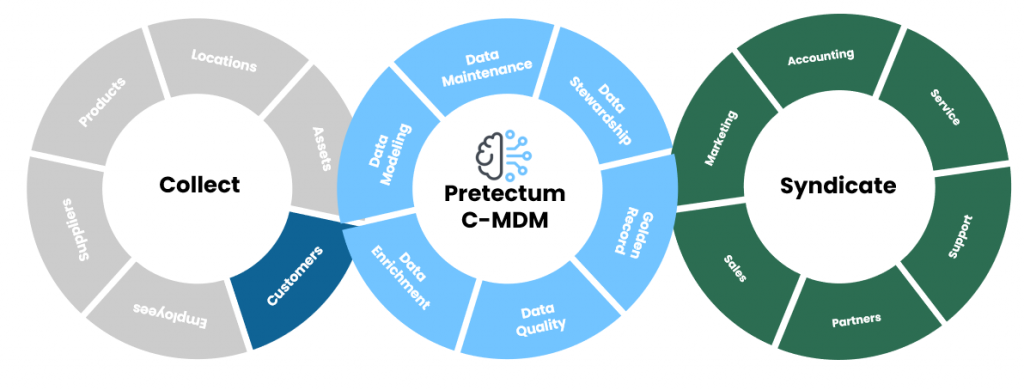A business that is able to process and utilize customer master data handling in real-time will find it brings great advantages for maintaining a competitive edge. Pretectum’s Customer Master Data Management (CMDM) platform is at the forefront of such capability, offering a robust platform that integrates, transforms, and utilizes customer data in real-time to enhance customer relationships and drive business success.
Integration and Centralization
One of the key benefits of Pretectum’s CMDM is its ability to integrate customer data from multiple sources across the organization. This centralization creates a single, unified view of each customer, often referred to as a “golden record” or “single customer view.” By consolidating data from various systems such as ERPs, CRMs, CDPs, and DMPs, businesses can ensure that all departments have access to the same accurate and up-to-date customer information. Such a unified view is essential for making informed decisions and delivering personalized customer experiences.
At the same time, Pretectum facilitates real-time data syndication, a process of distributing data to multiple channels or platforms simultaneously. Syndication ensures that customer data is consistently updated and available across all integrated systems, whether it’s a website, mobile app, or customer service platform. Consider a boutique retailer using Pretectum to securely integrate customer profile data automatically with customer loyalty program information in real-time, ensuring that customers can receive personalized offers and rewards based on their latest interactions using the best possible data without the associative risks of data leakage so commonly present when multiple applications are in use.

Data Assessment and Handling
The platform’s data transformation capabilities allow businesses to map and transform data into the required formats for different channels. This process is automated, ensuring that data is always consistent and accurate. When data is loaded into the system, it undergoes real-time transformation to align with the organization’s data standards, reducing the need for manual interventions and minimizing errors. Defined data schema with strong typing, lookup pick lists or defined patterns and masks mean that Pretectum CMDM supports robust data quality assessment that ensures data accuracy and completeness from the moment it is ingested.
The system performs real-time data validation, supports profile de-duplication efforts, and even data enrichment to maintain high-quality customer data. Such capabilities are particularly important during interactive data capture, where incorrect or incomplete information can be promptly identified and corrected. A customer can even update their contact information by themselves, the system validating this data in real-time to prevent errors and ensure that all subsequent interactions are based on accurate information.

Cross-Departmental Collaboration
The most effective customer data management approach is one that requires collaboration across various departments within an organization. Pretectum functions under these circumstances as a central resource, enabling teams from legal, compliance, IT, and customer service to access and contribute to customer data.
This federated and cross-functional participation in Customer Master Data Management means that organizationally, you have a unified approach to customer data management, one that ensures that all departments are aligned and working towards the same goals. Under this model, teams can use the platform to support a variety of customer-based initiatives such as targeting, segmentation and outreach, all the while providing customers with informed and personalized service and support since everyone is using a common understanding of the customer.
This concept of centralization is best served wit the added aspect of golden records, which serve as a cornerstone of the intent behind the Pretectum CMDM. By aggregating data from all and any available data sources, the platform can formulate a comprehensive and accurate customer profile. Unified views can include customer preferences, details on past behaviors, and interaction summaries. Unified profiles provide 360-degree understanding of each customer. In banking, for example, unified views allow the institution to offer highly personalized financial products and services based on a customer’s financial history and preferences.

Meeting privacy obligations and regulatory frameworks
Pretectum CMDM also includes self-service data verification and consent management features.
This capability means that customers can verify their own data and manage their consent preferences in real-time, ensuring that their information is accurate and up-to-date. This not only enhances customer trust but also helps organizations comply with data protection regulations. A customer that logs into their account and update their contact information or opts-out of certain marketing communications, can have these changes reflected immediately across all systems.
Compliance with data protection regulations is increasingly critical in all aspects of customer data management. Pretectum CMDM is able to inherently provides features such as data masking, encryption, access controls, audit trails, and consent management to ensure that customer data is handled most responsibly and in compliance with local, regional, and international privacy and consumer data handling laws.
Practical Real-World Examples
Several sectors are able to successfully implement real-time data processing using Pretectum CMDM to enhance customer relationships and stay competitive.
- Retail Loyalty Programs: Retailers that use CMDM can store key customer purchase indicators and preference data in real-time. This allows them to offer highly personalized on-the-fly, enhancing and forging closer customer engagement and encouraging repeat business.
- Cross-Channel Marketing: E-retailers that implement CMDM can integrate their past and new customer data from multiple channels, enabling a variety of data driven options based on customer demographics and other vital statics that may be tied to past behaviors or simply preferences. This holds the potential of offering more personalized and effective marketing strategies, leading to increased customer satisfaction and larger potential sales.
- Financial Services: Banks that use CMDM to create a unified customer views, can combine data from multiple systems like core banking, loans, credit and insurance databases to build personalized financial products and services. Such an approach improves customer satisfaction and helps banks meet compliance obligations in alignment with data protection regulations.
Pretectum CMDM’s real-time data processing capabilities present as an opportunity for a variety of industries to “lift their game” as they seeking to enhance customer relationships and maintain a competitive edge.
By integrating, transforming, and utilizing customer data in real-time, organizations can deliver personalized experiences, ensure data quality, and comply with data protection regulations. Whether it’s through real-time data syndication, cross-departmental collaboration, or self-service data verification, Pretectum CMDM provides a comprehensive solution for effective customer data management in today’s fast-paced business environment. Reach out today to learn more.


